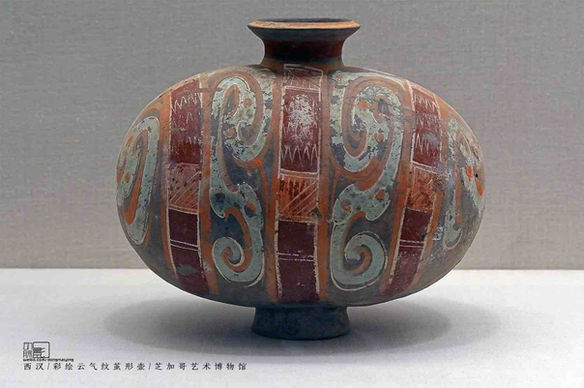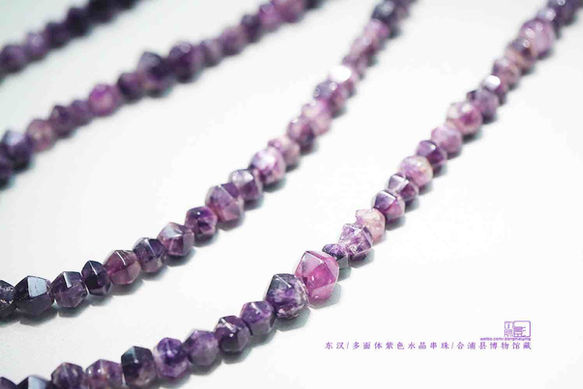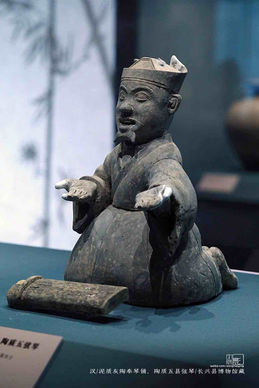Han Dynasty — The Golden Epoch of Legendary Civilians
The Han Dynasty (202 BC — 220 AD) stands as the second centralized empire in ancient Chinese history, and a golden era marked by advancements in the economy, agriculture, science, politics, and culture.
Notably, it was the first dynasty established by a civilian, ushering in an era where individuals could shine based on their talents rather than their family origins.
The Han Dynasty comprised two periods: the Western Han (202 BC — 8 AD) and the Eastern Han (25 AD — 220 AD).
The disruption of Han's rule in the middle occurred because a regent named Wang Mang seized the throne, establishing the Xin Dynasty (8 AD — 23 AD) and implementing a series of radical and controversial policies.
The Han Dynasty, lasting for 405 years, witnessed the rule of 29 emperors.

Jade Box of Han — Museum of the Western Han Mausoleum of the Nanyue King (Photo by Dongmaiying)
Brief History of the Rise and Fall of the Han Dynasty
Political Structure and Social Systems of the Han Empire
Han Dynasty Achievements in Science and Technology

Front Hall of Imperial Palace of the Han Dynasty (Weiyang Palace), based on Architectural Historian Yang Hongxun's Restored Model.
Han Dynasty Facts
-
The major ethnic group in China, the Han People, is named after this dynasty.
Chinese Character is named after this empire, too, the Han Zi.
-
Han had many civilian or slave-born emperors, queens, generals, and ministers. They gained everything through their extraordinary ability, not their family origin.
-
The Han Dynasty's largest city was its capital, Chang'an, which was three times bigger than the Contemporaneous ancient city of Rome.
-
Han was divided into two periods, the Western Han (202 BC — 8 AD) and the Eastern Han (25 AD — 220 AD); both transitions were triggered by internal disorders instigated by powerful clans associated with the queens.

Imperial Jade Seal of Queens of Han — Shaanxi History Museum (Photo by Dongmaiying)
-
Emperors of the early Han followed Taoism philosophy until Emperor Wu made Confucianism the dominant ideology.
-
Taoism Religion was formed, and Buddhism was imported to China during the Han era.
-
The 12 Chinese Zodiac Animals were officially set and widely used.
-
Smaller cities began to specialize in the division of labor, such as handicraft centers, commercial centers, etc.

Unearthed Eaves Tile of the Han Dynasty, With Inscriptions "Le Wei Yang" (Eternal Happiness) — Fujian Museum (Photo by Dongmaiying)
-
The first specialized public school in the history of China was built to teach talented people.
-
The government set up a department to manage prices and supplies of products in the market, which made a profit.
-
Professional historians were set to accurately record the daily activities of the emperors, including whom they met, what they said, with whom they had slept, etc.

Unearthed Brocade Barcer of Han — Xinjiang Museum (Photo by Dongmaiying)
-
Women’s social status was relatively high in the Han Empire; their rights started to decrease after the Tang Dynasty until down to the lowest point in the Qing Dynasty.
In the Han Era:
Women have the inheritance right to noble titles and property.
Children could use their mother’s family name.
Women could divorce and remarry as they wished, commoner or royal.
Princesses could also have toy boys.
-
Many emperors of Han were believed to be bisexual; the most famous one was Emperor Liu Ao.

Gilt Bronze Mirror of the Han Dynasty — Henan Museum (Photo by Dongmaiying)
Brief History of the Rise and Fall of the Han Dynasty
Founding Emperor Liu Bang and the Establishment of the Han
As a civilian-born commoner, Liu Bang joined the uprising when he was already 47 years old.
Among many uprising armies in the late Qin Dynasty (221 BC — 207 BC), Liu Bang's army was not quite famous initially.
However, seven years later, Liu Bang and his troops overthrew the powerful Qin, defeated other strong opponents, and built Han, China's second unified imperial dynasty.
His legendary experience set a good precedent for capable people.
After him, many civilian or slave-originated queens, generals, and ministers were talented and influential and weren't suppressed by their origins.
The successive three emperors were diligent and kind. They followed Emperor Liu Bang's governance ideas and further flourished the empire.
Seven feudal states allied together and initiated a big rebellion war, but were conquered soon.

Bronze Painted Light of Han, Burnt Smoke Gas can be Channeled Through the Neck of the Wild Goose into Its Belly — National Museum of China (Photo by Dongmaiying)
Expansion Under Reign of Emperor Wu
Then, Liu Che, one of the most accomplished monarchs in the history of China, Emperor Wu of Han, ascended to the throne.
He married a slave-born singer named Wei Zifu as his queen and nominated her brother, a slave-born hostler, as the leading general to fight against the Xiongnu, the strongest long-term enemy of the Han.
This general, Wei Qing, and his nephew Huo Qubing, successfully defeated the Xiongnu and vastly expanded the territory of the Han Empire.
Princess Jieyou and the first female diplomat Feng Liao contributed significantly to pacifying Han's borders and increasing Han's influence.
Emperor Wu also took advice from philosopher Dong Zhongshu and made Confucianism the dominant ideology.
During his reign, the Silk Road was opened up by the great explorer Zhang Qian.

Ruins of Yang Pass Constructed in Emperor Wu's Reign, An Important Gateway in the Silk Road that Connected the Middle Kingdom and West Regions. Photo by Sun Zhicheng
Prime and Decline of the Han Empire
But in the late years of Emperor Wu, he initiated many invasive wars and trusted the wrong people.
His crown prince and queen encountered a big political conspiracy and committed suicide after an intense but failed fight. His great-grandson Liu Xun, who was still a baby boy, ended up in prison.
However, this boy, Liu Xun, who was raised in prison and then lived in the civilian world, turned out to be a great emperor. The Han Empire reached its peak under his reign.
As a perfect monarch, Liu Xun left his prosperous kingdom to a less ideal heir. As a monarch, the next emperor, Liu Shi, was very soft and weak and then lost some power to the eunuch group.
Meanwhile, an even more ridiculous monarch, Emperor Liu Ao, inherited the throne.
He spent much of his adult life having fun with his male lover, then the beautiful dancer queen Zhao Feiyan and other imperial concubines.
At the same time, his mother’s clan, the House of Wang, obtained more and more power.

Bronze Artifact of Han with Inlaying Gold and Silver that used to Press Sitting Mat — Hebei Museum (Photo by Dongmaiying)
Ending of Western Han by the Controversial Wang Mang
In the year 8 AD, only a decade after Emperor Liu Ao passed away in his favorite concubine's bed.
Then, Han's regent Wang Mang, an excellent politician from the House of Wang, snatched the throne and established a new empire, which put an end to the Western Han Dynasty.
Emperor Wang Mang was widely suspected of being a time traveler because of a series of radical policies he had implemented.
But his reform didn't bring people wealthy and happy lives as he had promised; therefore, many uprising armies started to rebel.

Unearthed Clogs of Han — Chengdu Museum (Photo by Dongmaiying)
Re-establishment and Flourishing of the Eastern Han
Among many uprising armies, one of them was led by Liu Xiu, a descendant of Emperor Liu Bang, a royal family member.
He successfully defeated other forces and reestablished the Han Dynasty in the year 25 AD, which was called the Eastern Han Dynasty.
Emperor Liu Xiu inherited Han’s policies and systems, except for a few adjustments.
Like other unified kingdoms, this new Han Empire experienced notable developments and witnessed many brilliant heroes and their remarkable accomplishments, such as General Geng Gong and Diplomat Ban Chao.

Dragon Shaped Golden Belt Buckle of Han Decorated with Turquoises — Shouxian Museum (Photo by Dongmaiying)
Seizing of Power by Eunuch Groups and the Queens' Clans
Decades later, Emperor Liu Zhao ascended to the throne when he was still a kid, which allowed the current empress dowager and her clan to obtain supreme power.
When he was older, he gained power back with the assistance of the eunuch group.
For the second time, he brought back and empowered the eunuch group, which was believed to be a turning point for the Eastern Han.
Emperor Liu Zhao passed away young and left the empire to a toddler heir and his talented queen Deng Sui.
Deng Sui was a stunning queen, the last excellent female politician who managed the empire well while restraining the power of her clan.
After Empress Deng Sui passed away, in the following decades, strong clans of empress dowagers' and the eunuch group started to manipulate politics, who kept fighting against each other to obtain power.

Unearthed Embroidery of Han — Hunan Museum (Photo by Dongmaiying)
Disintegration and End of the Han Dynasty
Worse, Emperor Liu Zhi and Emperor Liu Hong even started selling political positions and noble titles for money.
Incapable emperors, intense struggles, corruption, mergers, and severe land acquisitions caused the appearance of some powerful warlords with large numbers of private forces.
When Emperor Liu Xie ascended to the throne as an 8-year-old, he was controlled by eunuchs and then powerful overlords. He tried his best to fight against those forces but never succeeded.
After his final counterattack failed, he was forced to abdicate the throne to the strongest warlord.
He then lived the rest of his life as a successful doctor while his enormous empire, the Han Dynasty, officially ended.
The whole country stepped into the divided Three Kingdoms (220 — 280) era.

Glass Bowl of Han — Nanyang Cultural Relic and Archeology Research Institute (Photo by Dongmaiying)
Political Structure and Social Systems of the Han Empire
Population
The population of the Han Dynasty, estimated to be around 15 million at its inception, experienced significant growth, reaching its peak at approximately 65 million.
Political System: Three Councillors and Nine Ministers System
-
The emperor held supreme power, and the officials in charge of the military, administration, and supervision (Three Councillors) directly answered to the emperor.
-
The other nine departments (Nine Ministers), responsible for managing finance, judiciary, ceremony, security, etc., operated independently of each other and reported directly to the emperor.
-
Vassal states and counties co-existed at the beginning of the Han Dynasty.
Decades later, Emperor Wu implemented a policy that gradually abolished vassal states.
-
The counties, with governors appointed, monitored, and assessed by the central government, replaced the semi-independent vassal states and came under the direct control of the emperor.

Lacquer Plate of Han — Hunan Museum (Photo by Dongmaiying)
Official Selection System
-
The emperor and the powerful minister could directly assign officers.
-
Governors of each county were required to recommend specific numbers of talented individuals to the central government, based on the local population.
However, these individuals had to pass certain exams to secure positions.
-
Graduates from the National Confucianism College would also be assigned appropriate positions.
Tax
Within the fiscal framework of the Han Dynasty, a comprehensive taxation system was in place.
This system encompassed one-thirtieth of farmland products, capitation taxes, and obligations for labor services.
Notably, individuals were afforded the option to fulfill their labor service obligations by making monetary payments

Currency of Han "Wu Zhu Qian" — Shanghai Museum
Military Service
During the Han Dynasty, a systematic conscription policy was in place, stipulating that every man aged between 23 and 56 was mandated to serve a two-year term in the army.
Typically, this service comprised one year within their local province and one year either in the capital city or on the border.
In times of war, the duration of service could be extended.
Additionally, during specific periods, individuals had the option to pay a fee to be exempted from military service, providing a degree of flexibility within the conscription system.
Land System
The Han Empire implemented a system of Private Ownership of Land, allowing civilians to own, cultivate, and sell their farmland while fulfilling their tax obligations to the state.

Inlaying Gold and Silver Bronze Crossbow (Nu Ji) of the Han Dynasty — Nanjing Museum (Photo by Dongmaiying)
Han Dynasty Achievements in Science and Technology
-
Invention and improvement of Paper Making Technology, by Cai Lun.
-
Invention and application of the Stirrup.
-
Invention and utilization of ancient narcotic drugs in surgeries by great doctor Hua Tuo.
-
Shen Nong Ben Cao Jing (Shennong's Herbal Classic of Materia Medica): the first Pharmacology masterpiece in Chinese history, documenting 365 medicines and 13 pharmaceutical theories.

Unearthed Plant (Ju) of Han, Used to Burn in Beacons of Great Wall at Night, to Send Info About Enemy — Dunhuang Museum (Photo by Dongmaiying)
-
Armillary Sphere (by Zhang Heng): equipment that can simulate the movements of celestials and planets.
-
Houfeng Seismograph (by Zhang Heng): the first equipment to predict and test earthquakes worldwide.

Armillary Sphere

Houfeng Seismograph
-
Zhou Bi Suan Jing (by Zhao Junqing): an astronomy and math book that introduced means of measuring and calculating celestial objects.
It first introduced and applied the Pythagorean Theorem.
-
The Nine Chapters on the Mathematical Art: A math masterpiece that introduces Fraction and Negative Numbers, and their operation rules, for the first time in the world.
It also demonstrates the problem of profit and loss, proportional distribution, important geometry, algebra, and equation sets.

Painted Ivory Ruler of Eastern Han — Shanxi Museum (Photo by Dongmaiying)
-
Taichu Calendar: the first complete calendar in Chinese history, which applied the 24 Solar Terms, and regulated that one year included 365.2502 days, and one month had 29.53086 days.
This meant the Chinese Lunisolar Calendar system was Officially established.
-
Wide utilization of the Abacus.
-
Chinese Magic Mirror: the mirror was made of bronze, but when the sunlight shines on the mirror, its patterns on the back are cast clearly on the wall.


The Magic Mirror (Tong Yang Sui) of Han — Yangzhou Museum (Photo by Dongmaiying)
-
Si Min Yue Ling (by Cui Shi): the only book in ancient Chinese history describing daily agricultural production activities. It records all production activities, from January to December, of a noble landlord’s manor.
-
Shang Han Za Bing Lun or Treatise on Cold Damage and Miscellaneous Diseases (by Zhang Zhong Jing): The first book about clinical therapeutics and one of the most influential medical masterpieces in Chinese medicine.
This is still the foundation course of Chinese medicine nowadays. Besides hundreds of valuable prescriptions, it also, firstly, in the world, recorded Artificial Respiration and Drug Coloclysis.
-
Opening up of the Silk Road.
-
Construction of Long Shou Qu, the first underground canal in Chinese history. It then disseminated through the Silk Road and turned into the Karez Well System in Turpan.
-
Invention and wide utilization of the Spinning Wheel.
-
Wide utilization of the Keel Waterwheel in agriculture.

Restored Model of Keel Waterwheel of Han — National Museum of China
Han Dynasty Art and Artifacts
Daily Necessities in the Han Dynasty
Unearthed Daily Necessities of Han (Photo by Dongmaiying)
Accessories and Cosmetics in the Han Dynasty
Unearthed Exquisite Accessories and Cosmetic of Women in the Han (Photo by Dongmaiying)
Potteries Reproducing Daily Life in the Han Dynasty
Unearthed Potteries Reproducing People's Daily Lives of Han (Photo by Dongmaiying)
Next: Three Kingdoms, Jin, North and South Dynasties (220 — 589) — Wars and Conspiracy
Related Articles:
Brief Introduction to Chinese History
Neolithic Era — Primitive Society and Mythical History
Xia Dynasty (Around 2070 BC — 1600 BC) — the First Hereditary Kingdom in China
Shang Dynasty (1600 BC — 1046 BC) — Empire of Bronze Age and Scripts on Oracle Bones
Zhou Dynasty (1046 BC — 256 BC) — Decency, Hierarchy, and the Feudalism System
Spring and Autumn Period (770 BC — 403 BC) — Great Philosophers and Contention of Warlords
Warring States Period (403 BC — 221 BC) — Wars Among the Seven Kingdoms
Qin Dynasty (221 BC — 207 BC) — Epoch of Great Unification
Sui Dynasty (581 — 618) — Transient Age and the Inaugurator of Prosperity
Tang Dynasty (618 — 907) — Flourishing Golden Age
Five Dynasties and Ten Kingdoms (907 — 979) — Decades of Wars and Chaos
Song Dynasty (960 — 1279) — Wealthy Empire with Tragic Encounters
Yuan Dynasty (1271 — 1368) — Half Anarchism
Ming Dynasty (1368 — 1644) — Epoch of All Round Prosperity
Qing Dynasty (1636 — 1912) — Extreme Centralization and Closure
Famous Historical Figures in Ancient China







































